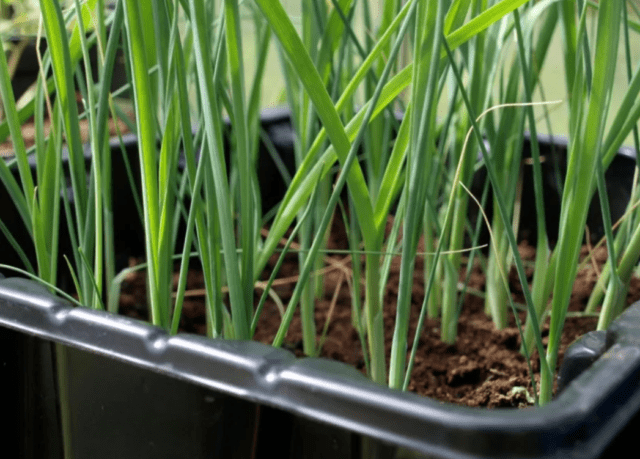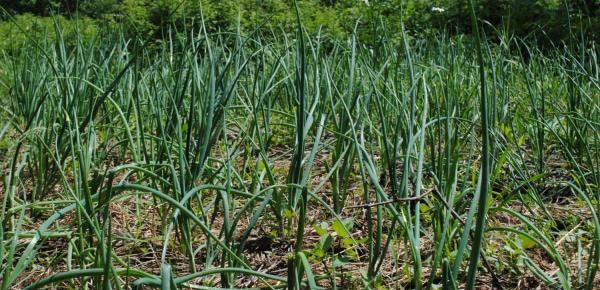Content
Onions are one of the “basic” crops in the garden plots of Russian gardeners. Among the many varieties and hybrids bred by domestic and foreign breeders, they most often choose those that are easy to care for, good taste, and the ability to adapt to the peculiarities of the local climate. The Stardust F1 bow meets all these criteria and is not without other advantages.
Origin story
Onion Stardust F1 is a hybrid bred by breeders from the Netherlands. The originator is the world famous agricultural company Bejo Zaden B.V.
Stardust onions can be considered a biennial variety. In the first season, it provides the gardener with a good harvest of greenery; the next year the bulbs ripen.
In Europe, the variety went on sale in the mid-90s. The application for admission to Russia was submitted by the originator in 1998.After variety trials lasting about a year, Stardust onions were officially recognized as suitable for cultivation in all Russian regions where gardening can generally be done. With the appropriate recommendation, it was included in the State Register in 1999.

The breeders set themselves the goal of creating a “two-in-one” hybrid, and they succeeded
Description and characteristics of Stardust onion
Feedback from gardeners and quite a long practice of cultivating Stardust onions in different countries allows us to assert that the hybrid almost exactly matches the description given by the originator. It can be grown in almost any conditions.
Appearance
The plant is quite powerful, with a thick neck. The leaves of the Stardust onion are erect, 20-30 cm high. They are colored green, typical of “feathers,” and covered with a not too dense layer of “waxy” coating.
The shape of the bulbs of the Stardust hybrid varies from almost round and slightly flattened to rhomboid and prismatic. The dry surface scales are silvery-white, the juicy internal ones are snow-white, as if with a pearlescent tint. Weight varies between 40-60 g.

The outer scales adhere weakly to the bulbs, but inside they are dense
Ripening time and yield
Stardust F1 is an early ripening onion. According to the originator, technical ripeness occurs 68-85 days after seed germination. However, many gardeners indicate a longer period - 90-100 days. Based on it, Stardust is a mid-season onion. This “scatter” is due to the climatic characteristics of different regions.The hybrid is heat-loving; cool summers can also “slow down” its ripening.
When grown for greens, Stardust onions are cultivated from seeds as an annual plant; they are characterized by high productivity and intensive leaf formation. One plant produces 30-50 g of “feather” per season, with 1 m² yielding up to 3 kg.
Bulbs can be obtained by planting seedlings that have ripened after the first season into the garden next year. Productivity varies between 4-6 kg/m². With quality care, you can raise this figure to 8 kg/m². If Stardust onions are cultivated on an industrial scale, the yield is 42-45 tons per hectare. At the time of harvesting, according to the originator, about 87% of the bulbs are ripening; after ripening, the percentage rises to 98%.

For greens, Stardust onions can be grown year-round in greenhouses
Resistance to diseases and pests
Stardust onions are rarely affected by diseases and pests. Breeders have provided it with high resistance (but not absolute immunity) to viral diseases typical of the crop, true and downy mildew.
For most pests, onions are basically inedible due to their caustic nature. However, those that are exceptions (onion fly, root and stem nematodes) are also not particularly interested in this hybrid.
Composition and properties
Stardust onion is very good for health. With a low calorie content (about 40 kcal per 100 g), it contains:
- vitamin C, E, PP, group B;
- macroelements (phosphorus, potassium, sodium, magnesium, sulfur);
- trace elements (iron, iodine, manganese, copper, zinc, aluminum, chlorine, fluorine, molybdenum, silicon, cobalt, chromium);
- organic acids;
- amino acids;
- phytoncides;
- flavonoids.
The positive effects of Stardust onion on the body are as follows:
- normalization of blood composition, reduction of sugar and cholesterol levels;
- restoration and maintenance of vascular elasticity.
- powerful antioxidant effect – fights free radicals, prevents aging of the body;
- strengthening the immune system, preventing seasonal colds, tuberculosis, streptococcal infections, spring vitamin deficiency;
- diuretic effect for kidney problems, severe edema;
- promoting the removal of sputum in diseases affecting the bronchi and lungs.
Stardust onion can also be used in home cosmetology to improve hair condition. They are rinsed with a decoction of the husk after washing; the pulp is used as a means to “activate” the follicles. Onion juice added to face masks evens out and restores healthy skin color.
Areas of application
Stardust onions are valued by gardeners due to their original taste and high juiciness. It is not too spicy, rather spicy, with a sweet aftertaste. Excellent qualities ensure versatility of purpose.
Stardust is especially in demand in European cuisine. When fresh, it is added to vegetable salads. It is also suitable for preparing onion soups, any main courses and side dishes, and homemade preparations for the winter.
Stardust onions are often used for pickling. It can also be frozen without losing the taste and juiciness of the scales. The hybrid is also suitable for drying.

The characteristic onion aroma of the hybrid is not particularly pronounced
Pros and cons of the variety
Onion Stardust has managed to remain popular among several generations of gardeners thanks to its significant advantages:
- high seed germination;
- consistently good yields of greens and bulbs, little dependent on the vagaries of the weather;
- relative ease of cultivation;
- the presence of good immunity, protection from certain pests;
- almost record keeping quality, good transportability;
- possibility of cultivation in a one-year or two-year cycle;
- early harvest, rapid growth of green mass;
- excellent taste of the bulbs, their one-dimensionality;
- high quality greens;
- ease of cleaning.
The only significant disadvantage of Stardust onions is the need to carefully regulate watering. With a lack of moisture, it loses its juiciness, acquiring an unpleasant bitter taste. If there is an excess of it, the bulbs quickly rot.

Stardust is one of the very few early white onion hybrids suitable for long-term storage
Methods for planting Stardust onions
Most gardeners cultivate the hybrid in a two-year cycle. First, the seeds are planted, producing onion sets Stardust F1.
The next season, full-fledged bulbs ripen from it.
Growing seedlings from seeds
The most common practice is to grow Stardust onion seedlings. When planting seeds in open ground, given the thermophilic nature of the hybrid, there is a risk that they will suffer from return frosts.
Before planting, seeds must be rejected by immersing them in a saline solution (25-30 g/l). Those without an embryo are much lighter, so they quickly float to the surface. Then the Stardust onion seeds are pickled for 30-40 minutes in a solution of fungicide or potassium permanganate (crimson-pink) to prevent fungal infections.
Growing Stardust onion seedlings is easy:
- Sprout the seeds by wrapping them in a damp cloth and leaving them next to the radiator for 2-3 days. Do not let the fabric dry.
- Plant the seeds in previously prepared containers with moist soil, deepening them by 1-1.5 cm. The interval between neighboring plants is 1.5-2 cm, between rows is 2.5-3 cm.
- Spray the soil, turn the container into a greenhouse, covering it tightly with cling film or covering it with glass. Ensure absence of light and warmth. Do not allow the soil to dry out or allow condensation to accumulate.
- After emergence, transfer to a bright place, lowering the temperature from 24-27 °C to 20-22 °C. Continue to monitor soil moisture.
- In the third leaf phase, pinch the “feathers”, shortening them by about 2/3.
Stardust onion seedlings are ready for planting in the ground 55-60 days after the seeds sprout. In central Russia this is the second half of April. They are planted at intervals of 7-8 cm with a row spacing of 15-20 cm. The holes and plants need to be well watered after planting. Until the seedlings take root, it is recommended to install arcs over the bed, stretching any white covering material over them.

Two weeks before transplanting to the garden bed, it is recommended to begin hardening off the seedlings.
Planting seedlings in open ground
Stardust onion sets must be inspected before planting, rejecting bulbs with traces of mold and rot, mechanical damage, any suspicious spots on the surface scales, as well as those that are obviously dry.
2-3 days before planting, they are disinfected, like seeds, and then thoroughly dried.Directly in front of it, with a sharp, clean knife, cut off the top and shorten the roots by about a third.
The location for the Stardust bow is chosen to provide it with enough light and protection from cold drafts. The soil will suit him is nutritious, but light, with a neutral acid-base reaction. The garden bed is prepared in the fall by digging it up, removing all debris, and applying fertilizer.

Without good lighting, you can’t count on a rich harvest of Stardust onions
Stardust is planted in well-moistened holes 4-5 cm deep. 10-12 cm are left between adjacent bulbs. The recommended row spacing is 20-25 cm.
Caring for Stardust onions
Caring for Stardust onions includes the following activities:
- Watering. The intervals are constantly adjusted, taking into account the frequency and intensity of natural precipitation. On average, one watering per week is sufficient if the weather is relatively cool. In hot weather, Stardust onions need to be watered twice as often. For 1 m², beds consume 5-7 liters of water. Watering is stopped 12-15 days before harvest. This is necessary so that the bulbs acquire juiciness and rich taste. But if the weather is very hot and dry, then the soil continues to be moderately moistened about once a week.
- Weeding and loosening. It is carried out as needed, at least once every 7-10 days. It is convenient to combine loosening Stardust onions with watering - wet soil is easier to cultivate. The plantings are loosened to a depth of 5 cm. Weeding cannot be neglected, otherwise the yield will drop sharply.
- Fertilizer application. Stardust onions are fed three times, at intervals of 10-12 days from the moment of planting.For the first time, mineral or organic fertilizers containing mainly nitrogen are applied. Further, plants require mainly phosphorus and potassium. You can feed them with wood ash or special purchased fertilizer for onions.
- Prevention of diseases. To avoid the development of fungal infections, experienced gardeners recommend dusting Stardust onions with sifted wood ash and colloidal sulfur. Instead of ordinary water, it can be watered once every 2-3 weeks with a weak solution of potassium permanganate or any biofungicide.
Conclusion
The Stardust F1 bow is quite a suitable option for a not very experienced gardener. The only important nuance in care that cannot be neglected is proper watering. Otherwise the plant is very unpretentious. Gardeners value the hybrid for its outstanding taste and consistently high productivity. This applies to both the green “feathers” and the bulbs themselves.
Reviews from gardeners about Stardust onions








